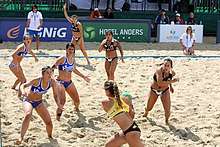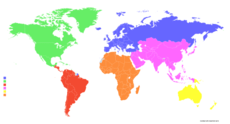Beach handball
Beach handball is a team sport where two teams pass and bounce or roll a ball, trying to throw it in the goal of the opposing team. The game is similar to standard handball, but it is played on sand instead of on a solid floor. Because the ball loses most of its bounce on sand, there is little to no dribbling, and players instead perform more passing as the rules of traveling still applies.
.jpg)

Matches are played as best two-out-of-three sets. If teams are tied at the end of a regular set then the teams play for a golden goal. If the teams are tied at the end of 2 sets then the teams will participate in a tie breaker. The tie break involves a goalie throwing the ball to their own player while that player attempts to score one-on-one with the opposing goalie. During regular play, if the goalkeeper scores a goal this counts as two points, compared to a normal goal scored by an outfield player which counts as 1 point. Creative or spectacular goals, such as 360 degree jumps and alley-oops, are awarded with two points, as well as in-flights and 6 meter throws.
The official rules of Beach Handball were internationally codified in 2002. The first European Championships was played in the year 2000.
As of September 2014, Brazil is ranked the number 1 country in the world, and is the winner of the world championship in both men's and women's divisions at the 2014 Beach Handball World Championships.[1]
- Competitions
- Beach Handball World Championships
- Beach handball at the World Games
- Beach handball at the World Beach Games
- IHF Youth Beach Handball World Championship
- Regional
See also
References
- "Beach Handball Carnival on the beach of Recife". ihf.info. 2014-07-27.
